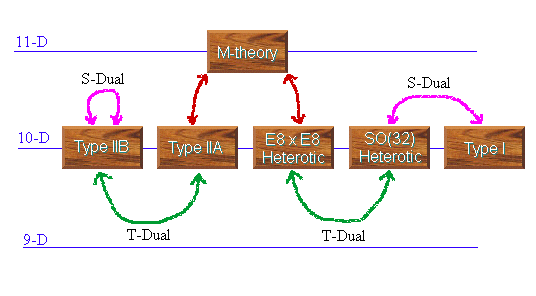
The five superstring theories appear to be very different when viewed in terms of their descriptions in weakly coupled perturbation theory. In fact the major revelation of the past few years is the fact that they are all related to each other by various string dualities. We say two theories are dual when they both describe the same physics.
The first kind of duality that we will discuss is called T-duality. This duality relates a theory which is compactified on a circle with radius R, to another theory compactified on a circle with radius 1/R. Therefore when one theory has a dimension curled up into a small circle, the other theory has a dimension which is on a very large circle (it is barely compactified at all) but they both describe the same physics! The Type IIA and Type IIB superstring theories are related by T-duality and the SO(32) Heterotic and E8 x E8 Heterotic theories are also related by T-duality.
The next duality that we will consider is called S-duality. Simply put, this duality relates the strong coupling limit of one theory to the weak coupling limit of another theory. (Note that the weak coupling descriptions of both theories can be quite different though.) For example the SO(32) Heterotic string and the Type I string theories are S-dual in 10 dimensions. These means that the strong coupling limit of the SO(32) Heterotic string is the weakly coupled Type I string and visa versa. One way to find evidence for a duality between strong and weak coupling is to compare the spectrum of light states in each picture and see if they agree. For example the Type I string theory has a D-string state that is heavy at weak coupling, but light at strong coupling. This D-string carries the same light fields as the worldsheet of the SO(32) Heterotic string, so when the Type I theory is very strongly coupled this D-string is becomes very light and we see the weakly coupled Heterotic string description emerging. The other S-duality in 10 dimensions is the self duality of the IIB string: the strong coupling limit of the IIB string is another weakly coupled IIB string theory. The IIB theory also has a D-string (with more supersymmetry than the Type I D-string and hence different physics) which becomes a light state at strong coupling, but this D-string looks like another fundamental Type IIB string.

The dualities between the various string theories provide strong evidence that they are simply different descriptions of the same underlying theory. Each description has its own regime of validity, and in certain limits another description takes over just when the original one is breaks down. What is this "M-theory" shown above? Go to the next page!
 |
 |
 |
 |